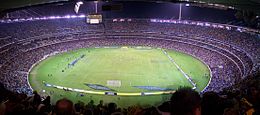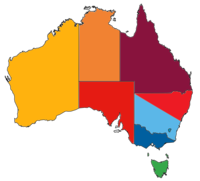| Revision as of 06:26, 30 August 2013 editHiLo48 (talk | contribs)Extended confirmed users, Pending changes reviewers, Rollbackers91,350 edits Reverted good faith change that really needs a source← Previous edit | Revision as of 07:11, 30 August 2013 edit undoSkyring (talk | contribs)Extended confirmed users22,610 edits Undid revision 570772474 by HiLo48 (talk) What's wrong with the source supplied?Next edit → | ||
| Line 10: | Line 10: | ||
| | teamlabel1 = National teams | | teamlabel1 = National teams | ||
| | nationalteam = ] (], ], ])<br>] (])<br>] | | nationalteam = ] (], ], ])<br>] (])<br>] | ||
| | first = |
| first = 1875, ] | ||
| | registered = 919,000<ref>{{cite web |url=http://www.ausport.gov.au/__data/assets/pdf_file/0018/436122/ERASS_Report_2010.PDF|title= Participation in Exercise, Recreation and Sport|author=<!--Staff writer(s); no by-line.--> |year= 2011|work= |publisher= Australian Government|page= 68|accessdate=22 March 2013}}</ref> | | registered = 919,000<ref>{{cite web |url=http://www.ausport.gov.au/__data/assets/pdf_file/0018/436122/ERASS_Report_2010.PDF|title= Participation in Exercise, Recreation and Sport|author=<!--Staff writer(s); no by-line.--> |year= 2011|work= |publisher= Australian Government|page= 68|accessdate=22 March 2013}}</ref> | ||
| | clubs = 1,200 (12,000 teams)<ref name="FIFA Big Count 2000">FIFA Big Count 2000</ref> | | clubs = 1,200 (12,000 teams)<ref name="FIFA Big Count 2000">FIFA Big Count 2000</ref> | ||
Revision as of 07:11, 30 August 2013
| Soccer in Australia | |
|---|---|
 The Australia national team playing at the Melbourne Cricket Ground The Australia national team playing at the Melbourne Cricket Ground | |
| Country | Australia |
| Governing body | Football Federation Australia |
| National teams | Men's (U-23, U-20, U-17) Women's (U-20) Beach soccer |
| First played | 1875, Goodna |
| Registered players | 919,000 |
| Clubs | 1,200 (12,000 teams) |
Soccer (shortened form of "association football") is a popular sport in Australia. The sport has a high level of participation in the country both recreational and professional. Football Federation Australia (FFA) is the national governing body which organises the A-League, the Australian national team, and the nine state governing bodies of the game. Modern soccer was introduced to Australia in the late 19th century by mostly British immigrant. The first club formed in the country, Wanderers was founded on 3 August 1880, while the oldest club in Australia currently in existence is Balgownie Rangers FC, formed 1883.
History
The first recorded game in Australia played under association football rules (known as British Association Rules at the time) took place at the Woogaroo Lunatic Asylum located in Wacol, on 7 August 1875 when the Asylum played Brisbane Football Club. The second earliest recorded game was played in Hobart on 10 May 1879 when the Cricketers Football Club played a scratch match. The first recorded inter-club match took place a month later when the Cricketers took on New Town FC on 7 June. This information predates what was thought to be the first recorded club, the Wanderers, founded by John Walter Fletcher in Parramatta 1880, and their first known recorded game under Association Football rules against the Kings School rugby football team at Parramatta Common on 14 August 1880. Later, in 1882, Fletcher formed the New South Wales English Football Association (also referred to as the South British Football Soccer Association), Australia's first soccer association and one of the first to be established outside the United Kingdom. The oldest existing club is Balgownie Rangers, founded in 1883, which still competes in the Illawarra regional league. The first inter-colonial game was played between Victoria and the neighbouring colony of New South Wales at the East Melbourne Cricket Ground in 1883. In 1884 both Queensland and Victoria formed their own associations, respectively the Anglo-Queensland Football Association (later to become the Queensland British Football Association in 1890) and the Anglo-Australian Football Association. The Western Australian Soccer Football Association was formed in 1896; the South Australian British Football Association in 1902; and a Tasmanian association about 1900. In 1911, the first Australia-wide governing body was the Commonwealth Football Association. This body was soon superseded when the Australian Soccer Association formed in 1921.
While Australians overwhelmingly played and watched Australian rules football or either code of rugby, soccer was highly popular with the various British and Southern European immigrant communities, all of which expanded rapidly during the 1950s and 1960s: Croatian, Greek, Italian and Serbian communities gave rise to most of the largest clubs. At the time, the game served as a bonding force within those ethnic minority communities, and as a point of identity amongst them and the wider Australian community. A similarly increasing number of British migrants also retained an interest in the sport. Johnny Warren, who was a member of the Australian national team at their first World Cup appearance, in 1974, entitled his memoir Sheilas, Wogs, and Poofters, giving an indication of how Warren considered the wider Australian community viewed "wogball" in the 1970s.
Participation
In 2010, 594,000 people played soccer at a club or organisational level, and 325,000 people played soccer recreationally at a non-organised level. These numbers were higher than the equivalents for other football codes commonly regarded as more popular in Australia, such as Australian rules football, rugby league and rugby union. The FFA has not been able to translate soccer's high participation rate into increased spectator numbers, preventing the game from generating greater revenue and making inroads into the other football codes.
Competitions
Main article: Australian soccer league systemThe league system in Australia since 1977 has involved a one divisional league controlled by the national body and many leagues run within each state below that with no promotion or relegation between the two.
National leagues
The National Soccer League (NSL) was established in 1977 and was the first national soccer competition in Australia, with teams in five states or territories. This league, and Soccer Australia, were disbanded in 2004 and replaced by the A-League and Football Federation Australia respectively.
The first season of the new league began in August 2005. The average attendance (including finals) for the inaugural season of 11,627 was significantly higher than the average of 4,119 for the NSL's final season.
The national women's league the W-League had its inaugural season in 2008 replacing the long dormant Women's National Soccer League as the national women's league.
The A-League National Youth League was launched in 2008–2009 to provide a reserve/youth league for competitors in the A-League.
Cup Competitions
There is currently no national FA Cup style knock out competition however each state, except Victoria and Queensland (who have regional cups), has its own cup competitions run by the state and territory federations. Some restrict the participants to only the top flight or semi pro clubs whilst others have more open entries via invitation or qualifying rounds. The oldest competition is the Australian-Croatian Soccer Tournament which has been running continuously since 1974. The highest cup competitions in each state/territory are:
- Waratah Cup (NSW)
- Dockerty Cup (Vic)
- Milan Lakoseljac Cup (Tas)
- Solo Cup (NNSW)
- Federation Cup (SA)
National teams
The Australian men's national team (nicknamed the Socceroos) represents Australia in international men's football. The team is a four-time OFC champion and AFC Men's Team of the Year for 2006. The team represented Australia at the FIFA World Cup tournaments in 1974, 2006 and 2010, and has qualified for the 2014 FIFA World Cup. The Australian Olympic team, Under-20 team, and Under-17 team also represents Australia in international men's football.
The Australian national women's team (nicknamed the Matildas) represents Australia in international women's football. The team has regularly qualified for both the Women's World Cup and the Olympics although has won neither. It has had success at the continental level, being a triple Oceania Cup winner, as well as winning the Asia Cup once. The Australian Under-20 team also represents Australia in international women's football.
Media coverage
Pay television is the predominant outlet for both domestic and international Soccer in Australia. Some games can also can be heard on local radio stations. The anti-siphoning list which controls what must be kept on free to air television in Australia includes only the FA Cup games. The Domestic A-League will be added to the anti-siphoning list, but not until 2014 in order to prevent a breach of contract on the part of Football Federation Australia.
Following a A$120million, seven-year deal between the FFA and Fox Sports, Fox Sports will have exclusive rights from 2007 to all Socceroos home internationals, all A-League and AFC Asian Cup fixtures, FIFA World Cup qualifiers through the AFC, and all AFC Champions League matches.
Fox Sports also has exclusive rights to the English Premier League and shows every match, with a viewers choice option available to viewers when multiple matches are being played at the same time.
SBS shows live UEFA Champions League and UEFA Europa League games and retains the Australian broadcast rights to the 2010 FIFA World Cup and 2014 FIFA World Cup finals. Pay Television stations (Fox Sports, ESPN and Setanta) also show Scottish, German, Argentine, Dutch and American leagues.
See also
References
- "Participation in Exercise, Recreation and Sport" (PDF). Australian Government. 2011. p. 68. Retrieved 22 March 2013.
- FIFA Big Count 2000
- Smeaton, Paul (18 February 2012). "How soccer was born in Goodna". The Queensland Times. APN News & Media. Retrieved 3 October 2012.
- "New Town v. Cricketers". The Mercury. 9 June 1879. Retrieved 26 July 2011.
- ^ "Timeline of Australian Football". New South Wales Migration Heritage Centre, Powerhouse Museum. 2006. Retrieved 4 December 2006.
- "Balgownie Rangers Soccer Club – Club History". 2006. Archived from the original on 24 August 2006. Retrieved 4 December 2006.
- "interstate soccer 1883". trove.nla.gov.au. Retrieved 18 August 2013.
- – Brisbane Courier 16 April 1914
- "Australian Football – Post 1974". New South Wales Migration Heritage Centre, Powerhouse Museum. 2006. Retrieved 4 December 2006.
- "Participation in Exercise, Recreation and Sport" (PDF). Australian Government. 2011. p. 68. Retrieved 22 March 2013.
- Hand, Graham (6 September 2010). "Despite the game's popularity, fans give soccer the big A (League)". Crikey. Private Media Pty Ltd. Retrieved 22 March 2013.
- "A-League Facts and Figures". Queensland Football. 8 February 2006. Archived from the original on 24 August 2006. Retrieved 5 December 2006.
- "Broadcasting Services (Events) Notice (No. 1) 2004" (PDF).
- "Socceroos games to be added to anti-siphoning list". Sportbusiness.com. Retrieved 26 July 2011.
- ^ "Historic deal to secure Football's future". 3 May 2006.
- "Football on Setanta Sports". Setanta Sports. Retrieved 12 July 2013.
- "Major League Soccer". ESPN Australia. Retrieved 12 July 2013.
| National teams |
| ||||||||||||||||||
|---|---|---|---|---|---|---|---|---|---|---|---|---|---|---|---|---|---|---|---|
| League competitions |
| ||||||||||||||||||
| Cup competitions |
| ||||||||||||||||||
| Others | |||||||||||||||||||
| Lists | |||||||||||||||||||
| Soccer in Australia by state and territory | ||
|---|---|---|
| Australian Capital Territory |  | |
| New South Wales | ||
| Northern Territory | ||
| Queensland | ||
| South Australia | ||
| Tasmania | ||
| Victoria | ||
| Western Australia | ||
| Sport in Australia | |
|---|---|
| By state/territory | |
| Team sports | |
| Individual sports | |
| International competitions | |